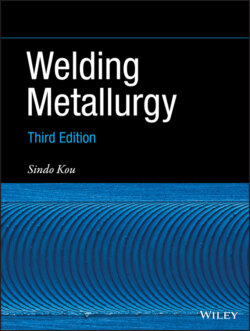Читать книгу Welding Metallurgy - Sindo Kou - Страница 29
1.3.2.4 Shielding Gases
ОглавлениеThe ionization potential is the energy needed to ionize a gas [6]. As shown in Table 1.2, the ionization potentials for argon and helium are 15.7 and 24.5 eV (electron volts), respectively. Since it is easier to ionize argon than helium, the electrical conductivity is higher and the voltage drop across the arc is lower with argon. Also, since argon is heavier than helium, it offers better shielding and greater resistance to cross draft than helium. With DCEP or AC, argon also has a greater oxide cleaning action than helium. These advantages plus the lower cost of argon make it more attractive for GTAW than helium.
Table 1.2 Ionization potentials for gases involved in arc welding.
| Gas | Chemical symbol | Ionization potential (eV) |
| Argon | Ar | 15.7 |
| Carbon dioxide | CO2 | 14.4 |
| Helium | He | 24.5 |
| Hydrogen | H2 | 13.5 |
| Nitrogen | N2 | 14.5 |
| Oxygen | O2 | 13.2 |
Because of the greater voltage drop across a helium arc than an argon arc, however, higher power inputs and greater sensitivity to variations in the arc length can be obtained with helium. The former allows the welding of thicker sections and the use of higher welding speeds. The latter, on the other hand, allows a better control of the arc length during automatic GTAW.
